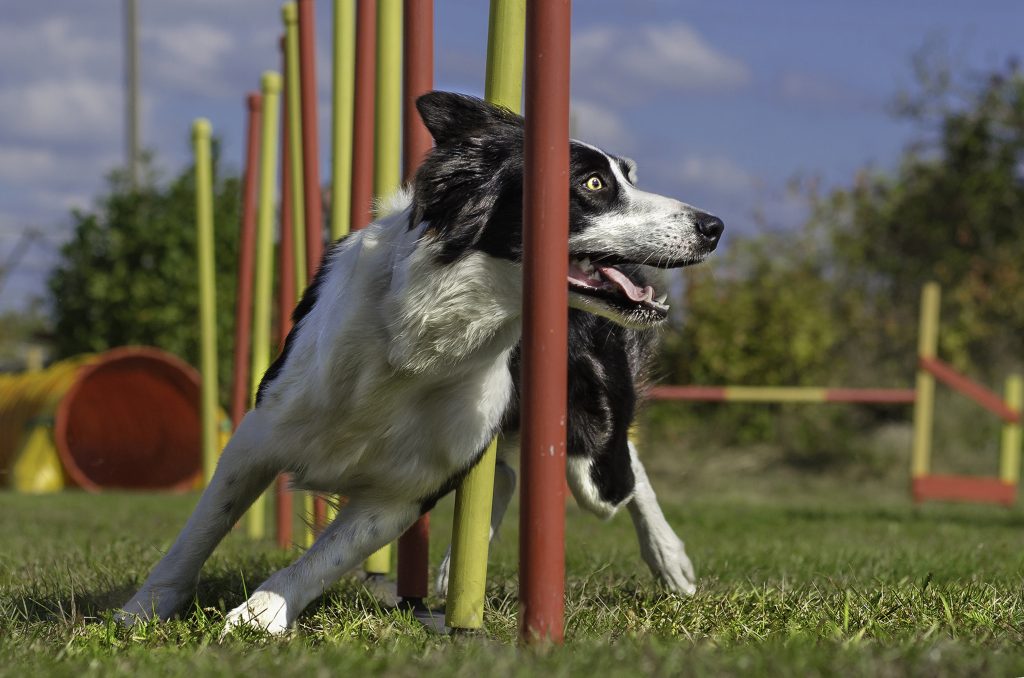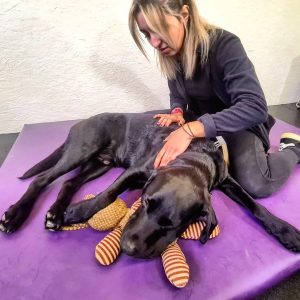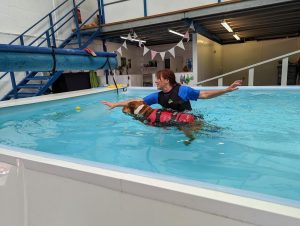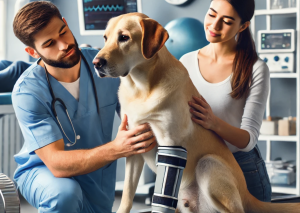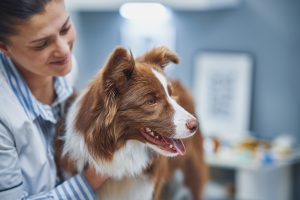Properly conditioned dogs perform better, are less likely to suffer injuries, when injury does occur they are less severe, and recovery is faster. Fit dogs also suffer less stress which translates to greater stamina and longevity, creating a win–win situation for both dog and handler.
In human athletics and sports, athletes will spend a large proportion of their time training in the gym and exercising appropriately for their chosen sport. In human sports, the exercises and conditioning we do should be appropriate for the activity we plan to do, for example a marathon runner will do very different training from that of a 100m sprint athlete. Just like humans, the ways we exercise and agility dogs is very different to what we should do with a cani-cross dogs.
By undertaking an appropriate fitness and conditioning programme, you can better prepare the dog’s body to undertake the tasks we ask of it. If your dog has the right strength, balance and flexibility it will be able to adjust itself better, handle more difficult tasks easier both of which may lead to better performance but more importantly reduce the risk of injury should things not go according to plan.
Slow motion analysis
Normal motion
Sporting motion
When you watch a dog in slow motion you can see how the body reacts to day to day tasks compared to that of an activity such as flyball, agility or cani-cross where a huge amount of forces are undertaken by the body.
In an agility round for example, the dogs body is required to handle a great effort of control, balance and strength. Not every run is smooth sailing and things can go wrong; under these extreme pressures dogs are asked to push to their limits control, strength and balance.
Evaluating your dog
A good way to evaluate your dog‘s fitness is to feel the size and tone of the core (both around the spine and abdominal areas) and rear limb muscles. The core body muscles are important for coordination of spinal and limb movements and are critical when immediate responses of the limbs are necessary. Since the front legs bear 60% of the dog‘s weight and all the weight of the dog plus the effects of gravity when a dog is jumping, cantering, or galloping, the front limbs get more exercise than the rear during regular activities.
Did you know our advance certified physiotherapist can conduct a thorough musculoskeletal check and undertake an objective stance analysis on our force plates to look for any minor issues before they become major issues? Contact us today to book your session.
Assessing your dogs structure
Did you know that dogs are the most varied species on earth? It is important therefore to understand how each dog is structured to design a conditioning programme that will take advantage of the dog‘s strengths and account for its weaknesses.
For example: German shepherd dogs generally have abundant rear angulation. This gives them a very long stride, allowing them to jump high and long, which can be an advantage in protection and police work. On the other hand, the same flexibility that gives them their rear angulation also means that they frequently experience hyperextension of various joints, particularly the toes and the carpi (wrists). They also can experience trauma to their hocks as they can hit the ground when running and jumping.
A balanced exercise approach
Strength Training
Strength exercises can be done in very small spaces as they include movements of the body over short distances. These exercises can be categorised as:
- Those that strengthen the front legs
- Those that strengthen the rear legs
- Those that strengthen the core body muscles
A great exercise for strengthening the front limbs is:
Teach the dog to wave each front paw (separately) higher than the head, holding it as long as possible
An excellent core muscle strengthening exercise involves:
Having the dog beg or sit up on its haunches, made more difficult by luring its head from side to side using a treat or on a soft surface such as a cushion
A great exercise for strengthening the rear is to:
Have the dog raise itself from the beg position to a stand and then back down to the beg position without letting the front legs touch the ground
Undertake a working dog assessment session with our physiotherapist to discover an exercise programme that suits your dogs need. Contact us today to book your session.
Endurance Training
The amount of strength and endurance training should be in proportion to the amount of each type of activity the dog does in its sport(s) or job. For the vast majority of working dogs strength is more important than endurance.
A typical endurance exercise involves trotting for at least 20 minutes continuously. It is essential for the dog to be in the trot gait for these exercises as this is the only gait that exercises both sides of the dog‘s body equally.
Swimming continuously for at least 10 minutes is another excellent endurance exercise.
Note: Endurance should not be mistaken for stamina. Of course, all working dogs need stamina— the ability to keep working for long periods of time.
Build endurance in your dog with hydrotherapy sessions in our specialist heated pool and our accredited hydrotherapists who’ll work not only the endurance aspects of your dog but target muscular development and flexibility. Contact us today to book your session.
Proprioception
Proprioception is the ability to know the spatial orientation of various parts of the body, especially the head, legs and feet, at any particular point in space and time. There are special receptors in the skin and muscles and joints that send messages along nerves to the spinal cord and brain about the movements of the body. These messages are then read and interpreted by the brain, allowing the dog to make coordinated movements such as landing from a jump, climbing over debris or grasping an object. Just like all nerves, those that govern proprioception can be trained.
For example, if you play a musical instrument, you know that when you first started to learn the instrument you had difficulty placing your fingers where they were supposed to be. But with practice your fingers became more accurate and your responses more rapid. Likewise, with practice, dogs can improve their proprioceptive abilities.
Preparation and Recovery
Did you know that humans that properly warm up before the 100-meter race are 7% faster?
Warm-ups before sports are also proven to reduce the incidence and severity of sporting injuries. Warm-ups should include movements that echo what the dog will do in its job, so warm-ups will be different for dogs with different jobs.
For a search and rescue dog a good warm-up could include some trotting, some jumps, some tugging, etc.
These exercises provide active stretches, in which the dog moves its own body through motions that are similar to those of the job it is about to undertake. It is best not to try to passively stretch a dog‘s limbs prior to exercise by lifting them and stretching them out. This can be uncomfortable and even can increase the risk of injury.
A good cool-down consists of gradually reduced exercise, such as a little trotting followed by walking, then a brief massage and some passive range of motion exercises. It is important to provide the dog with a cool-down period and watch carefully for signs of injury such as stiffness during the cool-down or when moving again after a rest period.
Canine Athlete Rehabilitation
The primary goal of physical rehabilitation is to heal and then to strengthen the affected limb/muscles while making sure to support the rest of the body through the healing and strengthening process.
Common physical rehabilitation modalities include:
- Therapeutic ultrasound
- Laser therapy
- Manual therapy
- Hydrotherapy
- Exercise prescription
Once the dog has reached pet-level fitness, the canine athlete or working dog will need to begin to retrain in the activities that he has to undertake to perform his sport(s) or job. The retraining program should begin with the components of his work that are least stressful to the body and best protect the dog from re-injury, then gradually progress to more complex physical requirements of the sport/job.
In addition, you must monitor your dog to determine whether the retraining program needs to be modified as some dogs are so driven to work that they risk re-injury, because the dog is just progressing more slowly than expected, or because other injuries surface that were masked by the more urgent injury.
Depending on the injury, it can take weeks to months of retraining to go from pet-level fitness to working dog fitness, although this is highly variable and can be discussed with your therapist.
A few words of puppy consideration:
- Dogs less than 6 months of age: Simple obedience training and non-impact skill training only
- Dogs over 6 months of age: Can undertake strength training exercises to build muscle
- Training that includes impact should wait until at least 14 months of age for the growth plates to close
- Spayed or neutered dogs, because of the delayed closure of growth plates, should delay high impact and endurance training until 20 months of age

